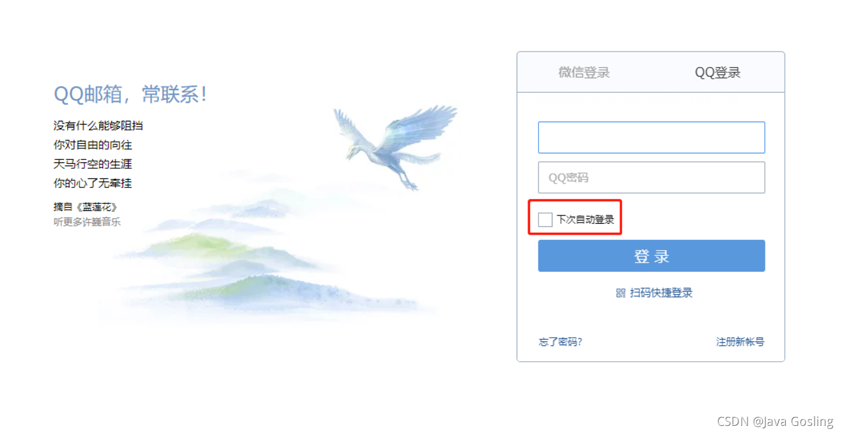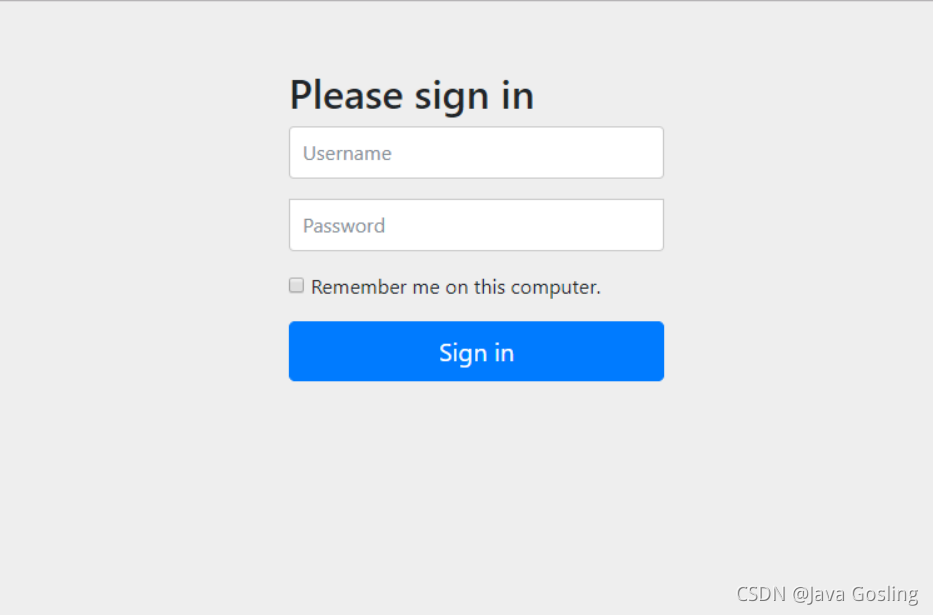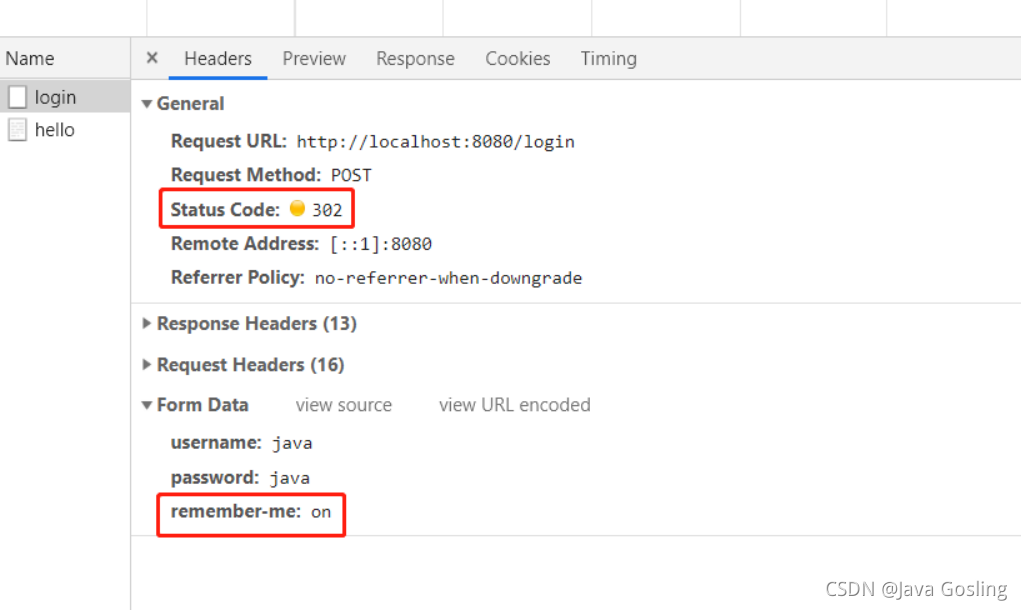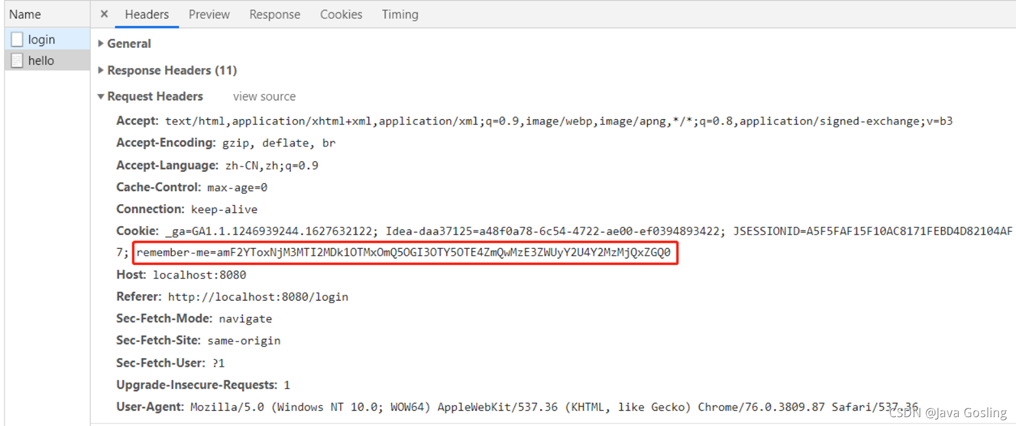这篇文章主要介绍Spring Security如何实现自动登陆功能,文中介绍的非常详细,具有一定的参考价值,感兴趣的小伙伴们一定要看完!
当我们在登录像QQ邮箱这种大多数的网站,往往在登录按键上会有下次自动登录这个选项,勾选后登录成功,在一段时间内,即便退出浏览器或者服务器重启,再次访问不需要用户输入账号密码进行登录,这也解决了用户每次输入账号密码的麻烦。

接下来实现自动登陆。
applicatio.properties配置用户名密码
spring.security.user.name=java
spring.security.user.password=javacontroller层实现
@RestController
public class HelloController {
@GetMapping("/hello")
public String hello() {
return "hello";
}
}配置类实现
@Configuration
public class SecurityConfig extends WebSecurityConfigurerAdapter {
@Override
protected void configure(HttpSecurity http) throws Exception {
http.formLogin()
.and()
.authorizeRequests()
.anyRequest()
.authenticated()
.and()
.rememberMe()
.and()
.csrf().disable();
}访问http://localhost:8080/hello,此时系统会重定向到登录页面。

二话不说,输入账号密码,开搞!
此时看到了登录数据remember-me的值为on,当自定义登陆框的时候应该知道如何定义key了吧。

在hello接口,可以很清楚的看到cookie里保存了一个remember-me的令牌,这个就是自动登录的关键所在。

至于令牌是怎么生成的,先看一段源码。核心处理类TokenBasedRememberMeServices->onLoginSuccess
public void onLoginSuccess(HttpServletRequest request, HttpServletResponse response, Authentication successfulAuthentication) {
//拿到用户名和密码
String username = this.retrieveUserName(successfulAuthentication);
String password = this.retrievePassword(successfulAuthentication);
//用户名为空 打印日志
if (!StringUtils.hasLength(username)) {
this.logger.debug("Unable to retrieve username");
} else {
//密码为空 通过用户名再去查询
if (!StringUtils.hasLength(password)) {
UserDetails user = this.getUserDetailsService().loadUserByUsername(username);
password = user.getPassword();
//查到的密码还为空 打印日志 结束
if (!StringUtils.hasLength(password)) {
this.logger.debug("Unable to obtain password for user: " + username);
return;
}
}
//令牌有效期的生成 1209600是两周 也就是说令牌有效期14天
int tokenLifetime = this.calculateLoginLifetime(request, successfulAuthentication);
long expiryTime = System.currentTimeMillis();
expiryTime += 1000L * (long)(tokenLifetime < 0 ? 1209600 : tokenLifetime);
//生成签名 signature
String signatureValue = this.makeTokenSignature(expiryTime, username, password);
//设置cookie
this.setCookie(new String[]{username, Long.toString(expiryTime), signatureValue}, tokenLifetime, request, response);
if (this.logger.isDebugEnabled()) {
this.logger.debug("Added remember-me cookie for user '" + username + "', expiry: '" + new Date(expiryTime) + "'");
}
}
}
//使用MD5加密 通过用户名、令牌有效期、密码和key生成rememberMe的令牌 这里的key也就是加密的盐值
protected String makeTokenSignature(long tokenExpiryTime, String username, String password) {
String data = username + ":" + tokenExpiryTime + ":" + password + ":" + this.getKey();
try {
MessageDigest digest = MessageDigest.getInstance("MD5");
return new String(Hex.encode(digest.digest(data.getBytes())));
} catch (NoSuchAlgorithmException var7) {
throw new IllegalStateException("No MD5 algorithm available!");
}
}看完了核心的源码,也就知道了令牌的生成规则:username + “:” + tokenExpiryTime + “:” + password + “:” + key(key 是一个散列盐值,可以用来防治令牌被修改,通过MD5散列函数生成。),然后通过Base64编码。
取出刚才的remember-me=amF2YToxNjM3MTI2MDk1OTMxOmQ5OGI3OTY5OTE4ZmQwMzE3ZWUyY2U4Y2MzMjQxZGQ0进行下验证。

解码后是java:1637126095931:d98b7969918fd0317ee2ce8cc3241dd4,很明显java是username,1637126095931是两周后的tokenExpiryTime,d98b7969918fd0317ee2ce8cc3241dd4是password和key值的MD5加密生成的。
需要注意的是key值是通过UUID随机生成的,当重启服务器时,UUID的变化会导致自动登录失败,所以为了避免之前生成的令牌失效,可以在配置中定义key值。
@Override
protected void configure(HttpSecurity http) throws Exception {
http.formLogin()
.and()
.authorizeRequests()
.anyRequest()
.authenticated()
.and()
.rememberMe()
.key("HelloWorld")
.and()
.csrf().disable();
}在Spring Security—登陆流程分析曾经说到 Spring Security中的认证授权都是通过过滤器来实现的。RememberMeAuthenticationFilter 是自动登录的核心过滤器。
public class RememberMeAuthenticationFilter extends GenericFilterBean implements ApplicationEventPublisherAware {
private void doFilter(HttpServletRequest request, HttpServletResponse response, FilterChain chain)
throws IOException, ServletException {
//获取当前用户实例 继续过滤校验
if (SecurityContextHolder.getContext().getAuthentication() != null) {
this.logger.debug(LogMessage
.of(() -> "SecurityContextHolder not populated with remember-me token, as it already contained: '"
+ SecurityContextHolder.getContext().getAuthentication() + "'"));
chain.doFilter(request, response);
return;
}
//登录获取Auth
Authentication rememberMeAuth = this.rememberMeServices.autoLogin(request, response);
if (rememberMeAuth != null) {
// Attempt authenticaton via AuthenticationManager
try {
//进行remember-me校验
rememberMeAuth = this.authenticationManager.authenticate(rememberMeAuth);
// Store to SecurityContextHolder
//保存用户实例
SecurityContextHolder.getContext().setAuthentication(rememberMeAuth);
//成功页面跳转
onSuccessfulAuthentication(request, response, rememberMeAuth);
this.logger.debug(LogMessage.of(() -> "SecurityContextHolder populated with remember-me token: '"
+ SecurityContextHolder.getContext().getAuthentication() + "'"));
if (this.eventPublisher != null) {
this.eventPublisher.publishEvent(new InteractiveAuthenticationSuccessEvent(
SecurityContextHolder.getContext().getAuthentication(), this.getClass()));
}
if (this.successHandler != null) {
this.successHandler.onAuthenticationSuccess(request, response, rememberMeAuth);
return;
}
}
catch (AuthenticationException ex) {
this.logger.debug(LogMessage
.format("SecurityContextHolder not populated with remember-me token, as AuthenticationManager "
+ "rejected Authentication returned by RememberMeServices: '%s'; "
+ "invalidating remember-me token", rememberMeAuth),
ex);
this.rememberMeServices.loginFail(request, response);
//失败页面跳转
onUnsuccessfulAuthentication(request, response, ex);
}
}
chain.doFilter(request, response);
}
}@Override
public final Authentication autoLogin(HttpServletRequest request, HttpServletResponse response) {
//获取cookie
String rememberMeCookie = extractRememberMeCookie(request);
if (rememberMeCookie == null) {
return null;
}
this.logger.debug("Remember-me cookie detected");
if (rememberMeCookie.length() == 0) {
this.logger.debug("Cookie was empty");
cancelCookie(request, response);
return null;
}
try {
//解码cookie 拿到令牌
String[] cookieTokens = decodeCookie(rememberMeCookie);
//通过令牌获取UserdDetails
UserDetails user = processAutoLoginCookie(cookieTokens, request, response);
this.userDetailsChecker.check(user);
this.logger.debug("Remember-me cookie accepted");
return createSuccessfulAuthentication(request, user);
}
catch (CookieTheftException ex) {
cancelCookie(request, response);
throw ex;
}
catch (UsernameNotFoundException ex) {
this.logger.debug("Remember-me login was valid but corresponding user not found.", ex);
}
catch (InvalidCookieException ex) {
this.logger.debug("Invalid remember-me cookie: " + ex.getMessage());
}
catch (AccountStatusException ex) {
this.logger.debug("Invalid UserDetails: " + ex.getMessage());
}
catch (RememberMeAuthenticationException ex) {
this.logger.debug(ex.getMessage());
}
cancelCookie(request, response);
return null;
}大致整体流程就是如果拿不到实例,则进行remember-me验证,通过autoLogin方法里获取cookie,解析令牌,拿到Auth,最后进行校验。之后剩下的和登陆流程分析的差不多。
以上是“Spring Security如何实现自动登陆功能”这篇文章的所有内容,感谢各位的阅读!希望分享的内容对大家有帮助,更多相关知识,欢迎关注亿速云行业资讯频道!
亿速云「云服务器」,即开即用、新一代英特尔至强铂金CPU、三副本存储NVMe SSD云盘,价格低至29元/月。点击查看>>
免责声明:本站发布的内容(图片、视频和文字)以原创、转载和分享为主,文章观点不代表本网站立场,如果涉及侵权请联系站长邮箱:is@yisu.com进行举报,并提供相关证据,一经查实,将立刻删除涉嫌侵权内容。